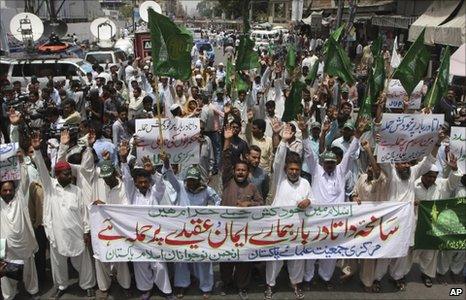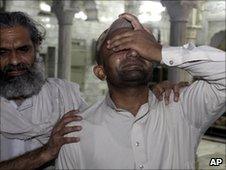Pakistani militants return to roots with Lahore attack
- Published

Protesters in Karachi condemned the Lahore suicide bombings
A double suicide bombing at a Sufi shrine in the Pakistani city of Lahore has been described as part of a growing trend of attacks on some of the country's minority Islamic sects. But as the BBC's Syed Shoaib Hasan reports, there is a long and bloody history of sectarian attacks in the country.
Rival sects have traditionally been the main targets for Punjabi jihadist organisations and their Taliban descendants.
In particular, Pakistan's Shias have been in the cross hairs since the rise of jihadist Islam in Pakistan in the late 1980s.
Hundreds of people, most of them Shia Muslims, died in the 1990s in attacks on mosques and processions.
Most of the attacks were carried out by an organisation which is now regarded as the deadliest militant group in Pakistan - Lashkar-e-Jhangvi (LJ).
The group broke away to continue an armed struggle along the lines of its parent organisation, Sipah-e-Sahaba (SSP).
That group envisages Pakistan as a Deoband (a sect of Sunni Islam) state - in which all other Muslims sects are treated as minorities.
In addition to Shias, those minorities include Sunni sects with roots in Sufi (mystical) Islam.
The main argument between the Deobandis and the Sufis centres around worship at shrines, which for Sufis involves music and mystical dancing.
The Deobandis, like the Wahhabi-inspired al-Qaeda, deem this to be heretical and a divergence from what they consider to be pure Islamic rituals.
However, the SSP has always maintained that it has adopted a political and constitutional route to implement its vision.
"We do not agree with anybody who takes up arms," Ahsan Farooqi, a SSP spokesman told me in Karachi recently.
"Anyone who takes up arms is expelled from the organisation."
Dangerous cadre
In the initial years, the jihadists confined their attacks to the Shia and other minority communities.
The primary reason was probably because Barelvi Islam - another Sunni sect - is practised by a majority of Pakistanis, although Deobandis have much state support.
But this sectarian violence declined considerably after the 9/11 attacks - and the US invasion of Afghanistan in 2001.
The jihadis were chased out of their strongholds in Afghanistan - and were subsequently captured or killed by Pakistani security forces.
In one blow the entire leadership was wiped out - but only for a younger and even more dangerous cadre to take charge.
Men like Riaz Basra, the founder of LJ, were killed - while others like deputy head Akram Lahori were captured and imprisoned.
But those who escaped were now beyond the control of their former masters in the Pakistani intelligence services.
Their numbers rapidly gained strength after then-President Pervez Musharraf banned Sipah-e-Sahaba and Jaish-e-Mohammad, a Kashmir-based militant group, in 2002.
"That was a landmark moment in the jihadist movement," a security official told me recently.
"The decision had been taken in effect to withdraw all state support for them. But cutting them loose basically did away with any influence we had over them.

The Lahore attack came as the Sufi shrine was packed with devotees
"That they continued to be militants should have come as no surprise - they knew nothing else," the official said.
"There should have been some sort of a rehabilitation programme or something to integrate these angry young men into society. Nothing however was done.
"Even those who were locked up were eventually released - and they became our most virulent opponents.
"Now we have no idea who they are - and what they are thinking."
This fact is attested by the SSP's Ahsan Farooqi - who argues that it was the actions of the security agencies that helped create the new breed of militants.
"The agencies pick up our boys and torture them. When they are released, all they can think about is revenge," he said.
"We do not condone their activities - but after such treatment what can you expect?"
Non-Deobands targeted
Post-9/11 though, most of the ire was reserved for the security agencies, which came under attack.
But the olds hatreds have remained - and now appear to have increased.
While Shias have always been treated as the primary enemy - the attacks on Ahmadis and Barelvi are by no means unusual.
In fact, one of the biggest attacks on a religious ceremony post-9/11 was on a Barelvi conference in Karachi in April 2006.
Over 70 people died in that attack, which investigators later said was carried out by the Lashkar-e-Jhangvi.
Since then, almost all non-Deoband sects have been the target of suicide attacks.
Thursday's attack is only the most recent in a series.
Shrines have been blown up across Pakistan, especially in the northern Khyber Pakhtoonkhwa province.
Attacks on Shias, and other sects, have also increased across Punjab province.
Dozens have been killed in attacks which continue in the southern port city of Karachi.
In many ways it seems, the militants have come full circle.
As rumours continue of a possible rapprochement with their old allies in the security forces, attacks on military installations have declined.
Increasingly, Pakistan's jihadist militants have started returning to their roots.
Flush with their new-found strength, the militants are turning their guns to their primary task - to fight the "heretics" within and purify the country.
- Published2 July 2010
- Published1 July 2010
- Published29 May 2010
- Published3 June 2010